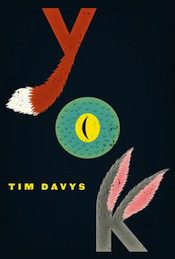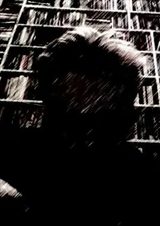
Life on streets of Tim Davys’ novel, Yok, is tough. Choices are hard, and knocks are harder. But the characters are soft. Squeezably soft. Stuffed with little more than fluff, the foxes, monkeys, goats, rabbits, and geckos in Tim Davys’ Aesop-esque fables nevertheless seek the denser stuff of life: love, freedom, wisdom, hope, integrity, forgiveness.
Take Fox Antonio Ortega, for example: “one of the most beautiful stuffed animals that had ever been delivered to Mollisan Town.” His mission in life? To woo and marry the beautiful daughter of crime boss Dragon Aguado Molina, Beatrice Cockatoo. Or Mike the Monkey rock star? What does he seek? “High on grass, low on booze, and feeling extremely sorry for himself”? He, of course, is seeking freedom (but also one good song). And what about the arrogant and fatalistic light yellow hare with the crocheted nose and warm pink silk ears? Vincent, why, he’s seeking the meaning of life, by lying, cheating, and hiding his inadequacy.
However, rather than embodying animalistic qualities (foxes are sly, monkeys are curious, hares are quick), Davys’ plush animals tend to personify human types, and for the most part, the animal traits of the characters have little bearing on the moral of the story. Instead, they epitomize exaggerated human types. And the moral predicaments that the fuzzy characters get into attempt to solve largely modern, rather than archetypical, dilemmas.
Yok is comprised of four unconnected stories, which are set in the neighborhoods of its namesake. Yok is a seedy district bordering Amberville, Lanceheim, and Tourquai; together, they make up the fictional world of Mollison Town. (The three remaining neighborhoods correspond to Davys’ three earlier novels.) Yok, then, is the final installment to the quartet.
As a fictional city, Mollison Town has many of the features of typical noir fiction: legislated morality and internal corruption; crime, drugs, poverty, and a grind-you-down sense of class rigidity; cynical protagonists and sexualized females; bleak industrialized settings; an atmosphere drenched with hopelessness and dystopian cynicism.

Erik the Gecko, for example, spends his days in the stygian bowels of a brewery shoveling chips into enormous spark-belching wood-fired ovens. Youngest brother of three orphaned cubs (all stuffed animals, regardless of their animal character, are cubs as youngsters), Erik toils away his evenings cooking and cleaning for his thug older brothers and waiting for his fairy godmother to bibbidi-bobbidi-boo him out of there. Waxing fatalistic, Erik says,
This masochism that I expose myself to daily, cuts into my soul, it may seem that I accept it without thinking, as if I enjoy being bullied and held down, but inside I’m burning up, as if someone were vomiting into my open mouth, and I swallow and want more and more, and it’s inconceivable, of course that every day I choose to continue and act as if I have no choice. Life is mysterious, and not a second goes by that I don’t despise myself for this self-imposed punishment that no one sees and no one promotes.
But like most victims (and unlike most variants of the unjust oppression/triumphant reward story), when luck does arrive, Erik can’t avail himself of it and therefore does not experience the reverse of fortune that makes other examples of this archetypical tale so satisfying. Consequently, his manifold ruminations amount to mostly empty epiphanies.
Likewise, Vincent Hare, who is obsessed with discovering the purpose and meaning of his life, seeks increasingly extreme measures to overcome the futility that he feels:
It was to this exact point here that life had taken him: to a deserted street in north Lanceheim after a day, or twenty-four hours, in an abandoned industrial space, with pain and degradation and drugs, so that everyone could anesthetize themselves to do what had to be done. This was his life, with a stranger’s vomit penetrating the cotton at his shins and anxiety like a lump in his throat. With an emotional life that only came to life from extremes or chemicals.
Vincent Hare stopped.
Did he want to be there?
Had he chosen this?
However, like other characters in the collection, Vincent Hare’s search leads him further from understanding and closer to existential void. The novel ends in this void; doubt and lack of conclusiveness permeate the stories and the collection in general. Most characters fail in their attempts to right their perceived faults or achieve self-actualization. In Yok, the big questions in life remain unanswered; life is small, plush, nasty, and brutish.
Yok, then, despite its cute and cuddly appearance, is a frighteningly familiar place, one that we encounter most days of our lives. To say that Yok is a philosophical novel, however, is a stretch. For one thing, the characters display inconsistencies in characterization and a tendency toward melodrama that undermine the novel’s ability to raise and answer serious humanistic concerns. A character should never be “on tenterhooks” twice in two pages. Also, the prose plods with under-description and an over-abundance of exposition. Yok’s 363 pages could have easily been edited down to four punchy short stories. The fact that it was translated from Swedish could also contribute to an oddness of voice. And finally, some of the fun aspects of the novel—plush anatomy, daily weather, and coloured streets—come off as over-reaching. Davys’ rendering of Gary the boxing vole’s lisp—“they thay it wath jutht to annoy me”—made me want to reach into the book and strangle him instead of pitying him.
However, if you have a penchant for noir fiction, which I admittedly do not, and you like stories and approaches that are unconventional, you may enjoy Yok. Despite my criticisms, I admire Davys’ intention to encourage the reader to feel the decay of moral society, experience the legacy of industrialized environments, and hold out hope for compassion and emancipation—for stuffed and human animals alike. Despite their inability to stop the forces of urban entropy, Yok’s fluffy protagonists deserve our empathy for reminding ourselves of us.




